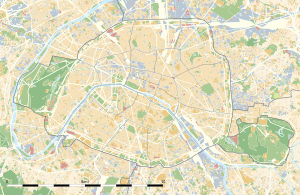This article needs additional citations for verification. (July 2018) |
| Tour de Nesle | |
|---|---|
| Part of wall of Philippe Auguste | |
| Paris in | |
 Tour de Nesle in January 1608 (detail from Patineurs sur la Seine en 1608, Carnavalet Museum) | |
| Coordinates | 48°51′27″N 2°20′14″E / 48.8575°N 2.337222°E |
| Type | Corner tower |
| Height | 25 meters |
| Site information | |
| Condition | Destroyed |
| Site history | |
| Built | circa 1200 |
| Built by | Philippe Auguste |
| Materials | Stone |
| Demolished | 1665 |
| Events | Tour de Nesle Affair |
The Tour de Nesle (French pronunciation: [tuʁ də nɛl]) was one of the four large guard towers on the old city wall of Paris, constructed at the beginning of the 13th century by Philip II of France and demolished in 1665.
The tower was situated on the left (south) bank of the Seine facing the old castle of the Louvre on the opposite bank. Originally known as the Tour Hamelin, it was a cylindrical structure of approximately 10 metres in diameter. The height was around 25 metres, with a stair turret reaching higher still. Later, the tower was incorporated into the Hôtel de Nesle, a medieval mansion.
On the right bank of the Seine river was a similar tall tower: the Tour du Coin (corner tower).[1] The towers protected the upstream approach to the Île de la Cité.
In 1308, Philip IV bought the tower from Amaury de Nesle.
In 1314, a scandal known as the Tour de Nesle affair implicated the daughters-in-law of Philip IV, who were accused of adultery. Many of the alleged liaisons were said to have occurred in the Tour de Nesle. The scandal led to torture and execution for the princesses' lovers and the imprisonment of the princesses, with lasting consequences for the final years of the House of Capet.
In 1319, Philip V donated the building to his Queen Jeanne de Bourgogne (the one accused who was found innocent) and she, in her will, left it for the College of Burgundy, which she founded for the University of Paris. Demolished in 1665, mansion and tower became the place of the Collège des Quatre-Nations (later occupied by the Institut de France) with the Bibliothèque Mazarine.
- ^ "L'enceinte de Philippe August. Vers 1300" [Wall of Philip II Augustus] (PDF). paris-atlas-historique.fr (in French).
